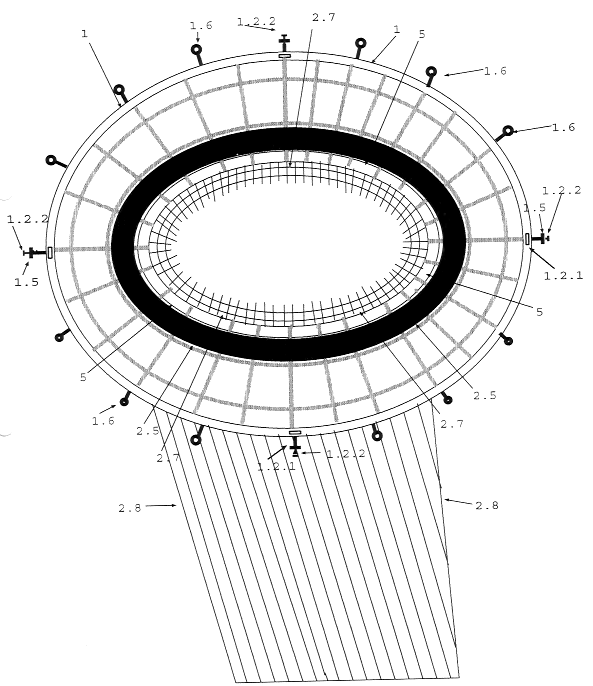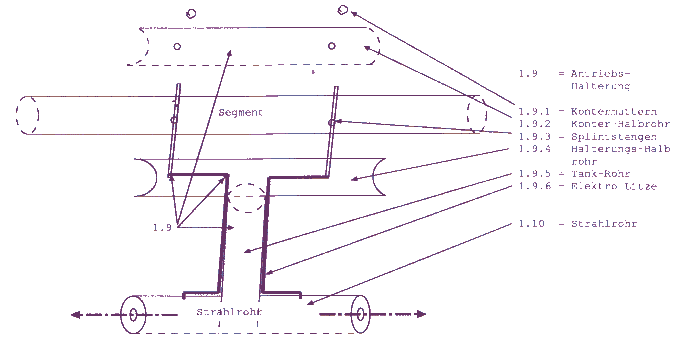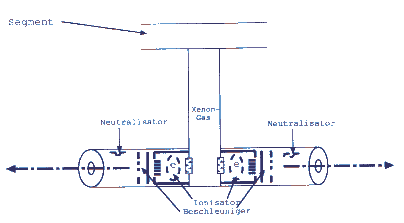
| POST & AUTHOR & Vision | RSS - Ring Skeleton Structure | LTH - Launcher Transport Head | EFO - Experimental Flying Object | RSC - Rotational Slingshot Catapult |
|
The bag was always a very light stowable device which can take on a lot of things but has not that much weight when empty.

Since electric thrusters with low thrust allow for gentle movements collecting and transporting with this craft can be done. The bag 2.8 is attached to the Thruster Ring through belts which also carry the solarcell arrays. The Outer Ring pipes, the belts, tethers or thread are preferably made of strong and lightweight nanotube like materials.
The thrusters are located in plugable complete thruster-tank units, each holding two thrusters in a thruster pipe. Each of the two thrusters fires to the opposite to itīs partner in the pipe. In conjunction with two partner complete units design were always two units are mounted conversely at the ring this allows to stop, accelerate, deaccelerate, turn the craft in each direction wanted without needing moveable thruster mountings - just through firing different thrusters. So this spacecraft is highly steerable.
Because of the complete thruster unit concept with easily changeable thrusters through plugging/unplugging the craft could get fueled and updated with better thrusters in a wash and at the same time.
In the drawing above we can see four thruster units 1.5 for turning the craft araund the disks centrum or for accelerating / deaccelerating the disk plane forward / backward or sidewards. Since this is possible just with two double units we have double redundancy.
The main propulsion thrust should come from the thrusters 1.6, which can push the the catching net towards the objects or deaccelerate to dump the. There are 12 double thruster units thought to be used at least for units together. So we have at least 3 times redundancy here.
Wouldnīt the craft get to much mass with such a lot of thruster units? If using for instance Russian SPT 60 hall thrusters each weighting about 1.2 kg for those 16 double thruster units we get about 40 kg for the thruster units without fuel.
If we would use a 10-m diameter outer ring made of CNT, this would account for about 6,0000 cubic cm = 7,8 kg earth weight. (diameter of the pipes 6 cm, 1 mm strength of the pipe walls, diameter of the ring 10 m = 10 m x 3,1428... x 6 cm x 3,1428 x 1 mm = about 60,000 cubic cm that is about 7,8 kg).
I admit I used the very optimistic numbers for carbon nano tube structures (not carbon reinforced plastics) which have been used through Edwards/Westling for the Space Elevator which may not be realistic for the near future.
This is how I imagine steering the Flying Space Bag. If you take a look on top of the thrusters 1.5 are cameras 1.2.2. They shall provide a stereo look as the craft would be the turning head. When the robonaut moves his head (or his whole body when he is using a wearable monitor) to the right, the craft would turn right, when he moves the head or his body to the left, the craft would turn left. He could also move his head up and down and the craft would move accordingly. He could than steer how much the thrusters are firing for acceleration or deceleration with his hands. Also with his hands he could switch an automatic stop function were the crafts thrusters are directed to stop an acceleration or a turn he just initiated to a standstill.
The flying Space bag could carry some gadgets like winches or roboter arms or flying magnets on itīs ring which can help to collect or hold objects.


The two splints of the bracket 1.9 run completely through the segment-pipes and are boltet onto them with counter nuts. The splints are also conductors for the electric power yielded from the solar-cells near the thruster-unit. Half-pipes (could be from metal) 1.9.2 enfold the segment pipes to give this joints some more strength since they have to resist heavy rotational forces.

| POST & AUTHOR & Vision | RSS - Ring Skeleton Structure | LTH - Launcher Transport Head | EFO - Experimental Flying Object | RSC - Rotational Slingshot Catapult |
|